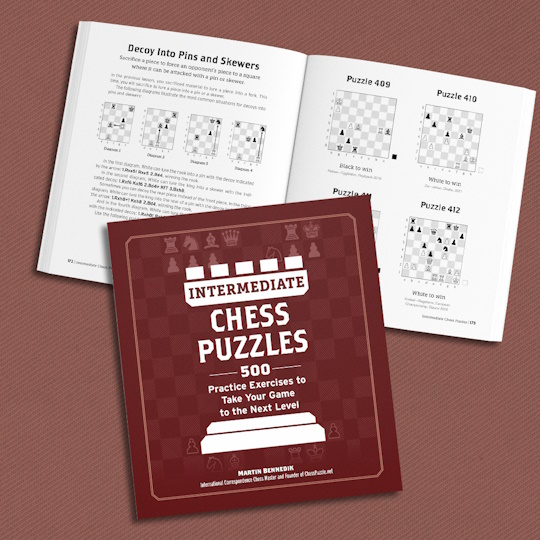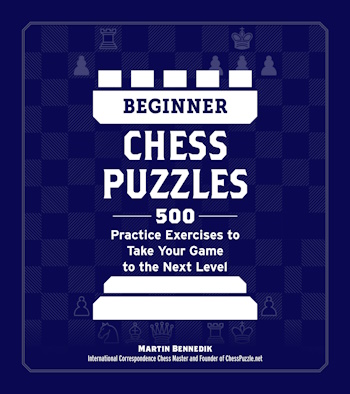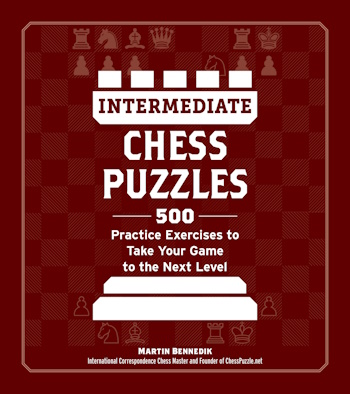Build new chess skills and practice key tactics with these books
ChessPuzzle.net: The Books
Based on the Puzzle Academy curriculum, I've written two books with chess puzzles:
Beginner Chess Puzzles and Intermediate Chess Puzzles, published by Simon and Schuster
What Readers Are Saying
"This book is the perfect gift for a player who has learned the basic moves of the pieces and would like to improve their game. These carefully selected puzzles are grouped according to theme and difficulty and will take a player to a new level of understanding. Positions are set out very clearly and the solutions are carefully explained."
— Daniel King, Chess Grandmaster, Coach, and Commentator
"Five stars! A valuable resource for anyone who wants to improve their tactical motif recognition. One of the few tactics books that is fun to work through."
— Michael Busse, Chess Tigers
Read full review (in German)
"Does the book achieve its aim? It does, and in a very instructive manner. I can easily imagine having this book as a beginner and I would absolutely devour its contents."
— Carl Portman, Chess Author and Club Player
Read full review
Games of beginners and intermediate players are all about tactics
Are you a beginner or an intermediate player? Forget about learning chess openings or strategy - the vast majority of games (more than 90%) played by beginners and intermediate players are decided by tactics. With these books you can learn tactics systematically by understanding the motifs and patterns, and by practicing them with puzzles.
Key Features of the Books
Comprehensive explanations for each motif and pattern: These books not just have puzzles, but are complete introductory texts to chess tactics with clear and detailed explanations of each key tactical motif and pattern.
Step-by-Step Solutions: Every puzzle is accompanied by a carefully explained solution, not just the correct sequence of moves, explaining how the tactical ideas work concretely.
Gradual Learning Curve: Unlike many other books that rapidly increase puzzle difficulty, this book follows a structured, gradual progression. You won't be left frustrated or stuck, but instead, you'll gain confidence as you advance through increasingly challenging puzzles.
Focus on Learning Through Progression: Each lesson covers a specific motif, reinforced with puzzles that gradually build on that concept. The workout sections challenge you by mixing motifs, simulating real-game scenarios to ensure you can recognize patterns on your own.
The Perfect Companion to Puzzle Academy

Combining the carefully selected examples in these books with Puzzle Academy's personalized learning and engaging with the material through a variety of media can significantly enhance your learning experience!
Distraction-Free Learning
Unlike digital platforms, these books provide a distraction-free space for concentration. Without notifications or the temptation to switch apps, you can fully immerse yourself in each puzzle.
Engage All Your Senses & ChessPuzzle.net Experience
Engage All Your Senses
Using more senses to engage with the material can help you remember it better. If you do find a puzzle more challenging, you can set it up on a real chess board and play out the moves. This exercise will use more senses - you can see the board in three dimensions and move and feel the pieces with your hand - which helps the brain learn better and remember the things you are learning!
Crafted with Experience from ChessPuzzle.net
I've used my experience with ChessPuzzle.net to make these books as effective learning tools as possible. By analyzing thousands of puzzles and understanding common pitfalls, I've tailored the content to address the specific needs of players at each level. This ensures that you're not just practicing puzzles but also building a strong foundation in chess tactics.

Beginner Chess Puzzles
Packed with five hundred puzzles and insights to help you hone your skills, this book will guide you as you learn and practice:
- Fundamentals of chess — including how to capture your opponent's pieces, how to defend your own pieces, and how to react when your king is in check.
- Tactics — forced sequences of moves that win your opponent's pieces, including forks, pins, and skewers; discovered attacks and checks; and removing the defense.
- Defense — including how to escape from a bad position with a stalemate, and how to avoid tactics for your opponent when defending.
- Checkmate patterns — enabling you to recognize the most common checkmates very quickly.
More order links below
Intermediate Chess Puzzles
Packed with five hundred puzzles and insights to help you hone your game, this book will guide you as you learn and practice:
- Difficult checkmate patterns — for example, discovered checkmate and double checkmate.
- Advanced tactics — including trapping pieces, interference, and intermediate checks and moves.
- Combinations — how to put together multiple tactical motifs to gain a material advantage. Combinations are the most complex and beautiful tactics.
- Defense — how to react when multiple pieces are attacked, how to defend against checkmate threats, and how to avoid your opponent’s tactics
- Checkmate combinations — how to weave together tactical motifs and checkmate patterns to force spectacular checkmates.
More order links below



